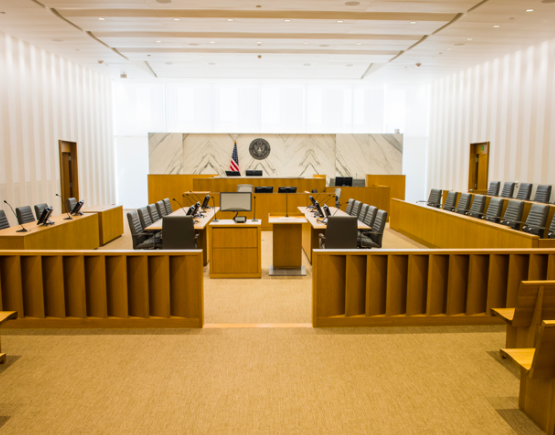
Central District of California in Los Angeles courtroom. (Photo: uscourts.gov)
New Court Trials in California
Within 10 days of filing the notice, the moving party must serve upon all other parties and file any brief and accompanying documents,
By Chris Micheli, February 16, 2025 2:30 am
Code of Civil Procedure Part 2, Title 8, Chapter 7, Article 2 deals with new trials. Section 656 provides a new trial is a re-examination of an issue of fact in the same court after a trial and decision by a jury, court, or referee.
Section 657 allows the verdict to be vacated and any other decision may be modified or vacated, in whole or in part, and a new or further trial granted on all or part of the issues, on the application of the party aggrieved. It is based on one of seven specified causes that materially affect the substantial rights of the party.
When a new trial is granted, the court is required to specify the grounds upon which it is granted and the court’s reasons for granting the new trial upon each ground stated. A new trial cannot be granted upon the ground of insufficiency of the evidence to justify the verdict or other decision, nor upon the ground of excessive or inadequate damages, unless after weighing the evidence the court is convinced from the entire record.
On appeal from an order granting a new trial the order shall be affirmed if it should have been granted upon any ground stated in the motion, whether or not specified in the order or specification of reasons, with specified exceptions.
Section 657.1 allows a new trial to be granted as provided. Section 658 says, when application is made for a cause mentioned, it must be made upon affidavits; otherwise it must be made on the minutes of the court.
Section 659 says the party intending to move for a new trial is required to file with the clerk and serve upon each adverse party a notice of their intention to move for a new trial, designating the grounds upon which the motion will be made and whether the same will be made upon affidavits or the minutes of the court, or other specified instances.
Section 659a states, within 10 days of filing the notice, the moving party must serve upon all other parties and file any brief and accompanying documents, including affidavits in support of the motion. The other parties have 10 days after that service within which to serve upon the moving party and file any opposing briefs and accompanying documents.
Section 660 provides, upon the hearing of the motion, reference may be had in all cases to the pleadings and orders of the court on file, and when the motion is made on the minutes, reference may also be had to any depositions and documentary evidence offered at the trial and to the report of the proceedings on the trial taken by the phonographic reporter, or to any certified transcript.
The hearing and determination of the motion for a new trial must have precedence over all other matters except criminal cases, probate matters, and cases actually on trial, and it is the duty of the court to determine the motion at the earliest possible moment. The power of the court to rule on a motion for a new trial expires 75 days after the mailing of notice of entry of judgment by the clerk of the court days after service on the moving party by any party of written notice of entry of judgment, whichever is earlier.
A motion for a new trial is not determined within the meaning of this section until an order ruling on the motion is entered in the permanent minutes of the court or signed by the judge and filed with the clerk. The entry of a new trial order in the permanent minutes of the court constitute a determination of the motion even though that minute order, as entered, expressly directs that a written order be prepared, signed, and filed.
Section 661 provides the motion for a new trial is to be heard and determined by the judge who presided at the trial; provided, however, that in case of the inability of the judge or if at the time noticed for hearing he is absent from the county where the trial was had, the same is to be heard and determined by any other judge of the same court. Upon the expiration of the time to file counter affidavits, the clerk must call the motion to the attention of the judge who presided at the trial, or the judge acting in his place.
Section 662 specifies, in a cause tried without a jury, the court may, on terms as may be just, change or add to the statement of decision, modify the judgment, in whole or in part, vacate the judgment, in whole or in part, and grant a new trial on all or part of the issues, or, in lieu of granting a new trial, may vacate and set aside the statement of decision and judgment and reopen the case for further proceedings.
Section 662.5 states, in any civil action where after trial by jury an order granting a new trial limited to the issue of damages would be proper, the trial court may in its discretion take either of two specified actions. If a deadline for acceptance or rejection of the addition or reduction of damages is not set forth in the conditional order, the deadline is 30 days from the date the conditional order is served by the clerk of the court.
Failure to respond to the order in accordance with this section is deemed a rejection of the addition or reduction of damages and a new trial limited to the issue of damages is granted automatically. A party filing and serving an acceptance of a conditionally ordered addition or reduction of damages must concurrently serve and submit to the court a proposed amended judgment reflecting the modified judgment amount, as well as any other uncontested judgment awards.
Section 663 specifies a judgment or decree, when based upon a decision by the court, or the special verdict of a jury, may, upon motion of the party aggrieved, be set aside and vacated by the same court, and another and different judgment entered, for either of the two specified causes, materially affecting the substantial rights of the party and entitling the party to a different judgment.
Section 663a says a party intending to make a motion to set aside and vacate a judgment must file with the clerk and serve upon the adverse party a notice of his or her intention, designating the grounds upon which the motion will be made, and specifying the particulars in which the legal basis for the decision is not consistent with or supported by the facts, or in which the judgment or decree is not consistent with the special verdict of two specified circumstances occur.
In addition, the power of the court to rule on a motion to set aside and vacate a judgment expires 75 days from the mailing of notice of entry of judgment by the clerk of the court or 75 days after service upon the moving party by any party of written notice of entry of the judgment, whichever is earlier.
The entry of an order to set aside and vacate the judgment in the permanent minutes of the court constitutes a determination of the motion even though that minute order, as entered, expressly directs that a written order be prepared, signed, and filed. The minute entry, in all cases, shows the date on which the order is entered in the permanent minutes, but failure to comply with this direction does not impair the validity or effectiveness of the order.
Section 663.1 allows the court to grant a new trial of any action or proceeding when all of the five specified conditions exist. In order to grant a new trial, it is unnecessary to have any bill of exceptions or statement of the case settled, but upon the facts recited in this section being shown to the satisfaction of the court by affidavit or otherwise, the court may grant the new trial.
Section 663.2 provides that, pending the hearing of a motion to grant a new trial, the time within which a bill of exceptions may be prepared, served, or presented for settlement is extended and cannot commence to run until the decision upon the motion. The motion must be made within 30 days after the loss or destruction of the records.
- Declaratory Relief - December 22, 2025
- Second Quiz on Where Areas of Law Are Found in the California Codes - December 21, 2025
- Bonds and Undertakings in California - December 21, 2025




One thought on “New Court Trials in California”